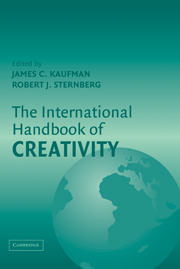Book contents
- Frontmatter
- Contents
- Acknowledgments
- List of Contributors
- 1 Introduction
- 2 Creativity Research in English-Speaking Countries
- 3 Creativity in Latin America
- 4 History of Creativity in Spain
- 5 Past, Present, and Future Perspectives on Creativity in France and French-Speaking Switzerland
- 6 Creativity in Italy
- 7 Creativity Research in German-Speaking Countries
- 8 Creativity Under the Northern Lights
- 9 Creativity in Soviet–Russian Psychology
- 10 Creativity Studies in Poland
- 11 Research on Creativity in Israel
- 12 Creativity in Turkey and Turkish-Speaking Countries
- 13 Development of Creativity Research in Chinese Societies
- 14 Creativity – A Sudden Rising Star in Korea
- 15 Culture and Facets of Creativity
- 16 African Perspectives on Creativity
- 17 Creativity Around the World in 80 Ways … but with One Destination
- Author Index
- Subject Index
- References
8 - Creativity Under the Northern Lights
Perspectives from Scandinavia
Published online by Cambridge University Press: 05 June 2012
- Frontmatter
- Contents
- Acknowledgments
- List of Contributors
- 1 Introduction
- 2 Creativity Research in English-Speaking Countries
- 3 Creativity in Latin America
- 4 History of Creativity in Spain
- 5 Past, Present, and Future Perspectives on Creativity in France and French-Speaking Switzerland
- 6 Creativity in Italy
- 7 Creativity Research in German-Speaking Countries
- 8 Creativity Under the Northern Lights
- 9 Creativity in Soviet–Russian Psychology
- 10 Creativity Studies in Poland
- 11 Research on Creativity in Israel
- 12 Creativity in Turkey and Turkish-Speaking Countries
- 13 Development of Creativity Research in Chinese Societies
- 14 Creativity – A Sudden Rising Star in Korea
- 15 Culture and Facets of Creativity
- 16 African Perspectives on Creativity
- 17 Creativity Around the World in 80 Ways … but with One Destination
- Author Index
- Subject Index
- References
Summary
This chapter is meant to cover the Scandinavian region of Europe. It includes research mainly from the discipline of psychology, but with excursions to the fields of education and philosophy. Besides theoretical and empirical results from Denmark, Norway, and Finland, it reviews data from both applied and laboratory settings in Sweden. The time span covered stretches back approximately three decades. At the start, only a handful of pioneers can be spotted, but the number of creativity researchers has increased rapidly over the years.
While pondering on the catch in our net, we have come to the conclusion that there is no typically or coherent Scandinavian opinion about how creativity should be understood. Still, Scandinavian work does not unconditionally reflect mainline North American approaches to the matter. If most American researchers would probably agree with Mumford's (2003) emphasis on productivity when evaluating creative behavior, Scandinavian researchers would be more inclined to pay attention to Runco (2003), who gives more weight to potentials. Here creativity is rather understood as an attitude toward life, a way to come to grips with the problems of existence. We believe that an exclusive focus on tangible creative products may lose sight of many creative individuals who do not give priority to being in the limelight.
Thus, there has been more focus on different conditions that are positive or negative for creativity, whether they are prerequisites in the individual or conditions seen from other angles in a system's perspective (cf. Csikszentmihalyi, 1999).
- Type
- Chapter
- Information
- The International Handbook of Creativity , pp. 202 - 234Publisher: Cambridge University PressPrint publication year: 2006
References
- 2
- Cited by



